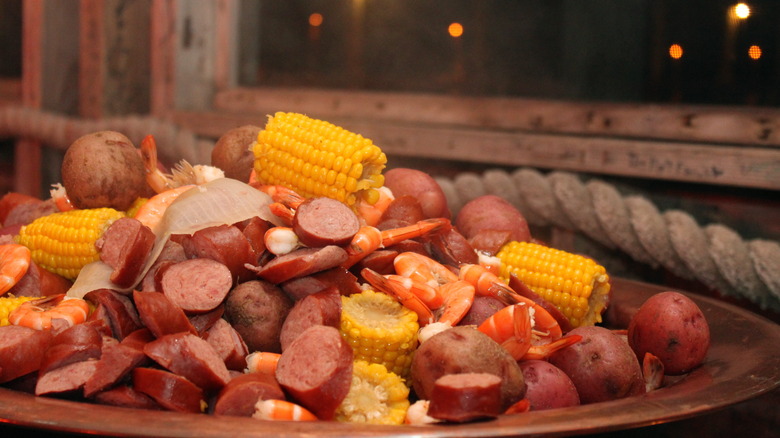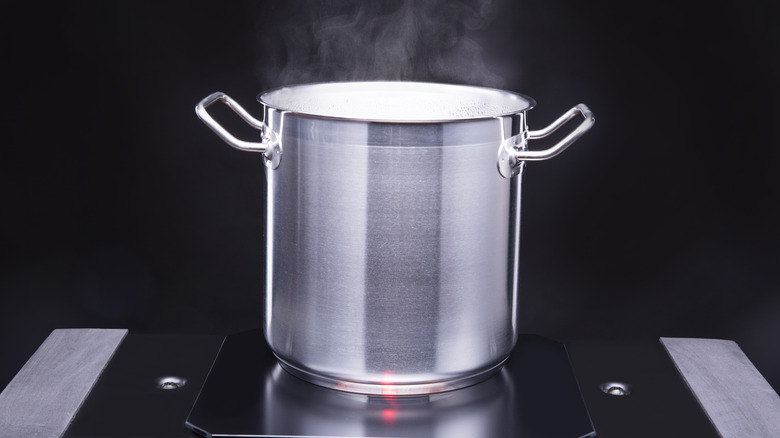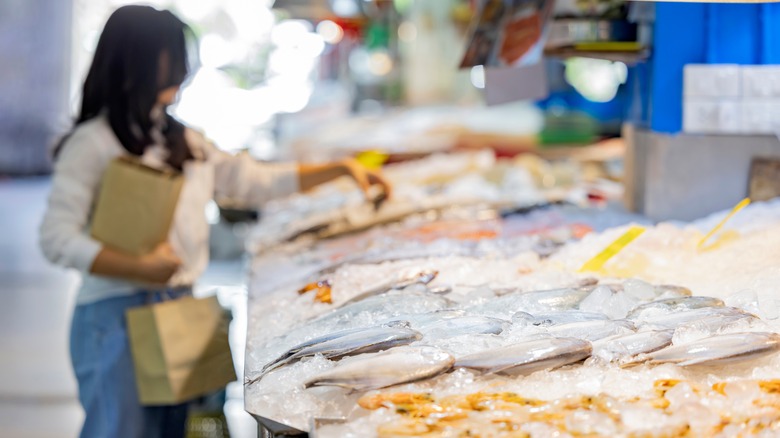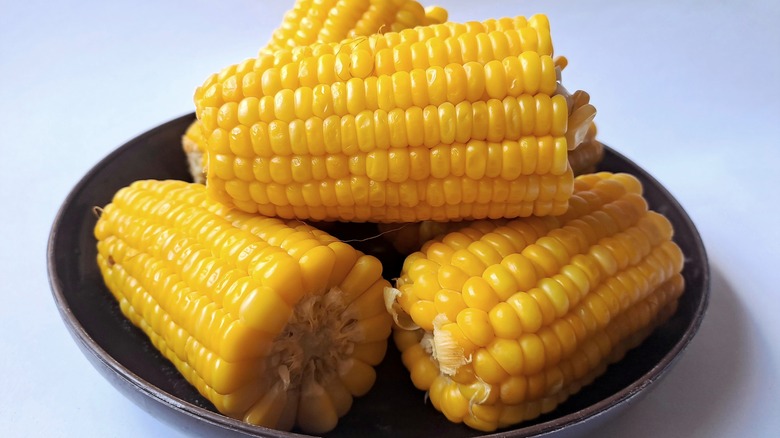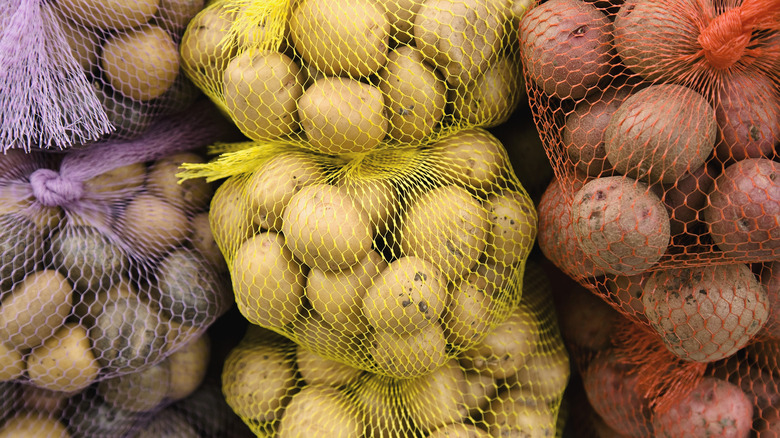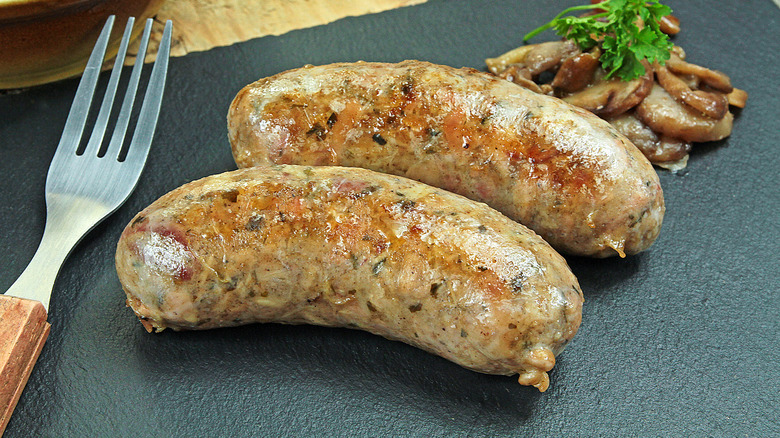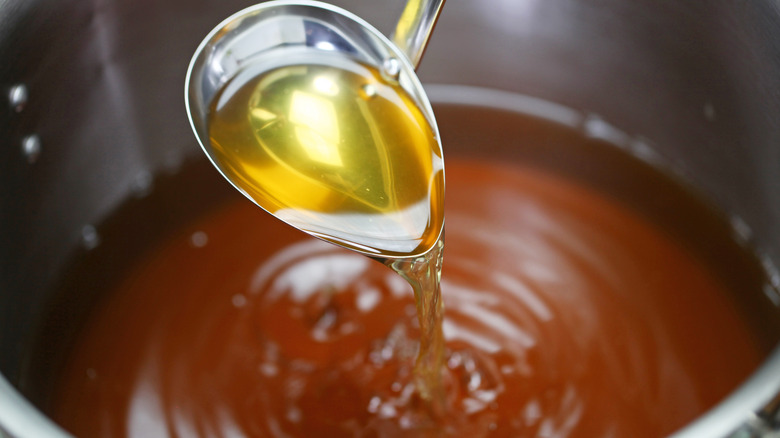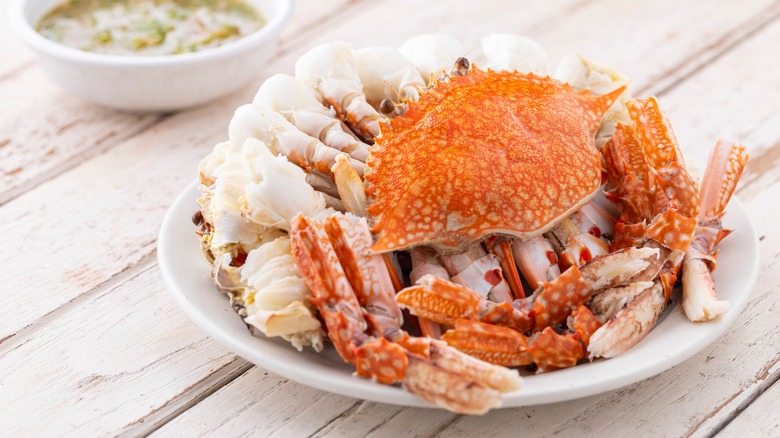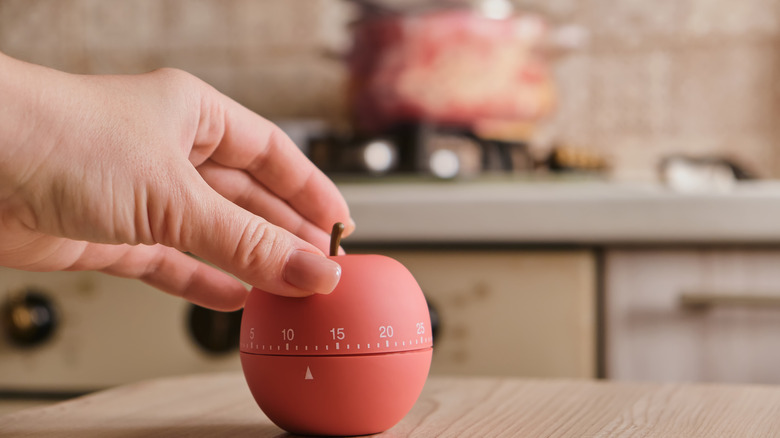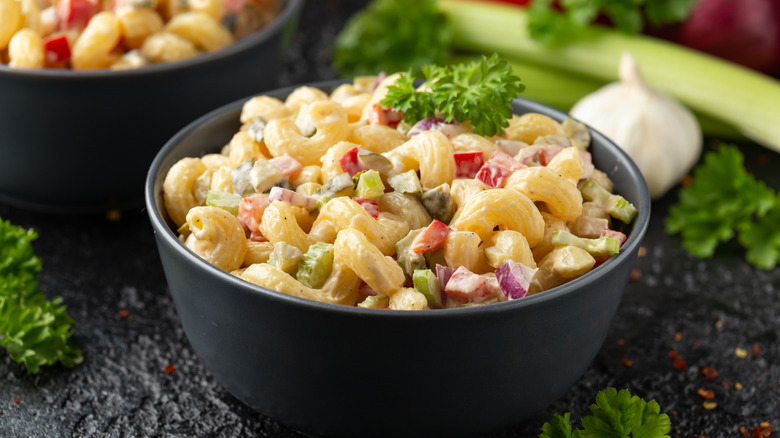The Ultimate Guide To Low Country Boils
Low country does not lie between borders on a map and is not comprised of certain zip codes, but is rather a community made up of oak trees, Spanish moss, sandy beaches, Southern charm, and lots of good food in low-lying coastal regions. One favorite dish has become more of a traditional event that brings people together than just a meal. These feasts usually take place in South Carolina or Georgia, although they're now enjoyed all over and have become synonymous with Southern food. A low country boil is known by many names, but is commonly and affectionately referred to as a country or seafood boil or Frogmore Stew among those who love seafood, good company, and lots of flavors.
As with most traditional dishes, there are new and old takes on the classic, with varying ingredients and recipes. However, a few things seem to remain true no matter where you're from. Low country boils are an easy meal to cook up for a large group of people. Cooking the ingredients in one pot and piling it all onto newspapered table tops is a little messy, but it's the best way to enjoy a fun and delicious meal together. Bumping elbows and lots of napkins are inevitable. This meal, with its perfect blend of local seafood, hearty starches, and vegetables, has a little bit of something for everyone. There's a reason low country boils are a time-honored tradition in the South and beyond.
The history of low country boils
Low country boils are common throughout the South during the fall when the weather turns cooler and they often serve up the local catch, such as shrimp and crab. The easy list of ingredients made it simple to dish out a large, hot meal for family and friends when they gathered and it quickly became a popular favorite. The exact recipes have changed over the years, and they may bring to mind outdoor barbecues, and red and white checkered tablecloths, but a low country boil or a seafood boil is deeply rooted in Southern history and goes back to before the Civil War.
This traditional meal can be traced back to the Gullah who are African Americans that live in the southern coastal parts of the United States and continuously work to preserve their African heritage. Traditions, such as their English-based Creole language, clothing, food, and music are still practiced today and passed on to younger generations in the hopes of keeping their culture alive and thriving in the United States. The Gullah brought many styles of cooking to the region and frequently served up seafood boils for friends and family. More recently, it's believed that a National Guardsman named Richard Gay, prepared a family recipe for a large group of soldiers and the heaping hot meal was such a success that it quickly became known as Frogmore stew, which was named after the guardsman's hometown.
What's in a low country boil
The ingredients of a low country boil have become an ongoing disagreement. Some use beer, some don't, and some claim crab legs or crawdads are absolutely not part of the recipe, while others choose to toss them in every time. The tradition with many names, such as Beaufort Stew, a Beaufort boil, or tidal stew, is typically made of these ingredients, though it's ultimately up to the cook in the kitchen.
The first step of the process, which should not be overlooked, is the broth. This usually contains salt, lemon, and, most importantly, Old Bay seasoning. The strong spice in the seasoning is what causes such a delectable aroma. The dish also needs a hearty potato, usually red or yellow. Andouille or kielbasa sausage is cut into three-inch pieces and added. Corn on the cob is cut into smaller manageable pieces, and finally, shrimp tops off the whole dish.
The great thing about a boil like this is that you can make it all in one pot. Clean-up is easy, and there aren't too many ways to mess it up. As long as your broth is seasoned correctly, many other ingredients can be added to stretch the dish or to include your favorites. Although these are the traditional ingredients, it's common to see many other ingredients added to the pot.
How to cook a low country boil
The most common way to prepare a low country boil is with a large pot that will fit all your ingredients. You begin by bringing the broth to a boil and adding each ingredient separately, depending on what will cook the fastest. Don't crowd your ingredients. If one pot isn't large enough, it's better to evenly cut the ingredients in half and divide them between two pots. It's important to cook all of the ingredients together to get that delicious, powerful flavor throughout the meal. For example, don't add the corn, and potatoes in one pot and cook the shrimp and sausage in another. This method is simple because you only need to cook the ingredients, drain the liquid, and pile the food onto the table.
Another option is to cook the meal in a crock pot. The timing will be slightly different, and with this method, many opt to make this more of a soup and keep the broth.You could also cook the dish in the oven, or on top of the grill in a roasting pan. If you're using this method, be sure to still add your broth to the bottom of the pan, and you'll need to wait to add the shrimp to avoid overcooking. You may also want to pre-cook the potatoes to avoid undercooking them.
The ideal shrimp varieties to use
Fresh and local are the most important things to remember when choosing what to use in a low country boil. The seafood, after all, is where a lot of your flavor comes from, which means you want to make sure it's top quality. There are several types of shrimp to choose from, depending on the size and flavor you are searching for. In fact, there are more than 300 species of shrimp in the world. Rock Shrimp or white shrimp are frequently used because they are local in the southern parts of the U.S. known as the low country, although various types of brown, pink, and white shrimp can be caught in the area.
Rock Shrimp and other brown shrimp are excellent choices because of their sweet, robust flavor. The shrimp appear brownish or gray when they're uncooked, but if you boil them for just two to three minutes they become a light pink color. You can purchase cleaned, deveined shrimp from local seafood markets, but they're also easy to come by in the supermarket.
If you choose uncooked shrimp, they will cook rapidly and become C-shaped when they are ready. Drain the broth after the shrimp is done cooking immediately to avoid overcooking the seafood. Overcooked shrimp will maintain its flavor, but the texture can quickly go from firm to tough and chewy. Remove your shrimp from the heat once they are a C shape or an O shape is overcooked.
Choosing the right kind of corn
There are several types of corn available, and they can be vastly different in terms of color, flavor, and texture. If you're staying true to the low country boil tradition by using local ingredients or even growing them yourself, be sure to select sweet corn. There are over ten different types of sweet corn. For a low country boil, you want to choose either Golden Bantam, Honey Select Hybrid, or Jubilee Hybrid. These options will provide a vibrant yellow color and a sweet flavor that is the perfect contrast to salty potatoes and savory sausage. The right kind of corn offers a burst of refreshing sweetness that goes perfectly with the mix.
When preparing your corn, cut it into smaller four-inch chunks that can easily fit in your pot and on your plate. You can add a spoonful of butter to your broth or lather it on once it's done cooking, but the many flavors in the pot should season the corn plenty. The corn will absorb the spices as it all cooks together, providing plenty of spicy, sweet flavors. There are other kinds of corn that you can use, such as hybrids that are a mixture of white and yellow kernels. These types also have a nice sweet flavor; however, they don't always get the same soft texture. Avoid all other types of corn, as they'll be too tough and starchy for a low country boil.
The best types of potatoes
Die-hard low country locals might tell you that the one and only type of potato that should end up in a seafood boil is a small red potato, and for good reason. Red potatoes will soften up, absorb flavor, and the red skin offers bright colors, delectable flavor, and lots of good vitamins. You can toss in whole red potatoes if they're small or cut them into cubes. They're bound to be a crowd-pleaser without requiring any additional seasoning or butter. Red potatoes have a slightly firmer flesh as well, which means if your timing is slightly off, they won't turn to mush as fast as other types if you accidentally overcook them.
However, several other types of potatoes can work in a low country boil. Yukon yellow potatoes contain more vitamin C, and they have a softer, less starchy flavor than some white potatoes they cook up to be a nice pleasant color in a low country boil. Avoid overcooking these, though, or they'll become mashed potatoes right before your eyes. Other white potatoes can be used in a pinch, but their starchy flavor can be hard to mask, even with all of the added seasonings. A mixture can always be used, but always remember that different types cook faster than others. Always add your potatoes to the pot first, and do not completely cook them before adding the other ingredients, as the corn and sausage will need time to thoroughly cook too.
Different types of sausage to choose from
The sausage is another important ingredient in a true low country boil. The sausage will impart tons of flavor, and it's really the meat of the whole meal if you aren't a big seafood fan. As the low country boil originated from The Gullah, it is unsurprising that many French, Cajun, and Creole influences made their way into the dish. The most commonly used and traditional type of sausage is Andouille, which is believed to have originally hailed from France. This smoked sausage is often found in other Cajun dishes, such as Jambalaya and Gumbo because its spicy yet smoky flavor works well with popular spices.
Cajun spices such as paprika, cayenne pepper, garlic, and onion powder are often mixed into the sausage and contribute to the delectable flavor. The sausage is typically dried, smoked, and then boiled before eating. Other types of sausage are comparable to Andouille, such as Polish kielbasa and Chorizo, because of the spicy, smoky flavor. The sausage is usually cut into three-inch chunks and added to the pot after the corn and potatoes. Most Andouille sausage is precooked, so it doesn't require a long cooking time, but it should be heated thoroughly.
Mastering the broth
Perfectly seasoned broth can make or break your low country boil. It's the first step: Although the other ingredients will provide a lot of flavors, nothing will really pull it together the way a well-made broth can. Depending on how large your pot is, fill it with a few quarts of water. Some choose to pour in a pale beer for extra flavor, and you can add in a few cups of chicken or vegetable stock. Next, you can season the broth with garlic powder, salt, cajun seasoning, or lemons, but the most important ingredient is Old Bay seasoning. The mixture of spices is identifiable by its pungent aroma and is crucial for your broth.
Old Bay seasoning is made up of celery seed, salt, red pepper, black pepper, and paprika. Together, these smoky flavors were made for seafood boils. The potatoes, corn, and shrimp will soak up these spices until the taste is utter perfection. The trick to seasoning your broth with Old Bay is to use just a little more than you think you should. If you're using eight quarts of water, you can use approximately a half cup of Old Bay. Bring the broth to a rolling boil, which gives the water and spices plenty of time to meld together. In addition, you will be straining the broth away as soon as all of the ingredients are cooked, and you want some of the seasoning to remain behind for maximum flavor.
Additional ingredients
If you're the chef for the moment, you're free to get as creative or remain as traditional as your heart desires. If you are feeling a bit adventurous or simply want to add your own flare to a classic, consider adding these additional ingredients. Crab legs are frequently enjoyed in the South, and that means they often find their way into a Tidal Stew. You can toss in a whole blue crab, just their claws, or for larger, sweeter pieces of meat, add in some Snow Crab legs. They will also take on the smoky, spicy flavors nicely. Not to mention, seafood boils are already messy, so why not throw some crab legs in?
Crawfish, clams, and mussels are other common seafood options that can go well with these traditional seasonings. Be sure to account for different cook times and add them at the appropriate time to avoid overcooking. If you're hoping to incorporate a little more green or just vegetables, in general, to this meal, add broccoli, red or yellow peppers, celery, or carrots to the mixture. Finally, don't skip over the finishing touches and take your low country boil to another level. Garnish the pile with a few lemon wedges to make it accessible for those who prefer a little extra tang. Chop fresh parsley to sprinkle over the pile as well, this provides a pop of green and a perfect final touch.
Timing is everything
A low country boil doesn't require sharp culinary skills or expensive equipment. You essentially toss everything into a pot and then pile it unceremoniously onto the table. However, there is a little finesse required to serve up perfectly cooked ingredients. Follow these steps, and you'll end up with a new crowd-pleasing favorite.
Begin with a rolling boil and add your potatoes. Boiling water will help shorten the cooking time and thoroughly cook all of the ingredients. Once the potatoes are bobbing, bring the water back to a boil and let them cook for five minutes. Keep checking your potatoes with a fork. They should remain a little firm when you add your sausage and corn. You'll need to boil the corn for about ten minutes for it to soften up, which you can time well with the sausage. The sausage should be precooked, so you really just need to heat it through, which should take about ten minutes. Once the sausage and corn are tender, your potatoes will also be ready.
The final step will be the shrimp. The seafood portion only needs about two minutes to cook, and the water doesn't need to be at boiling point. Most people toss in the shrimp, cover the pot, and cut the heat. In a few minutes, your shrimp should be C-shaped and perfectly cooked. Immediately strain the broth and have your melted butter and cocktail sauce ready because you won't want to wait, and it will cool quickly.
What to serve with low country boils
An authentic Frogmore Stew will be served atop newspaper with sides of cocktail sauce and melted butter for an authentic experience. However, what is a true feast without a few side dishes? For a well-rounded delectable meal, whip up some other Southern classics, such as crispy, crunchy fried okra. Coleslaw is a creamy vegetable side dish that goes perfectly with these seasonings and even better with a pile of Hushpuppies. A big bowl of macaroni salad or a pot of perfectly seasoned rice and beans are a little more involved, but they also go great on the side.
For those feeling extra motivated or those with friends who want to bring a dish along, aim for more seafood and stay on theme. Bacon-wrapped scallops are the perfect addition, or steamed clams also work as an appetizer. Fried catfish, with a crispy breading and a fresh squeeze of lemon, is another Southern favorite that will not go uneaten at a low country boil. Oysters, fried or on the half shell will also fit right in with the menu, though they also require a little more work.
